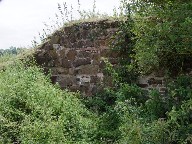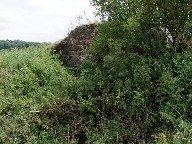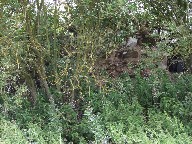
home I index I latest I glossary I introductions I e-mail I about this site
St Margaret, Wallington
Read
the captions by hovering over the images, and click on them to
see them enlarged.



St
Margaret, Wallington
And yet, it did not seem to be exactly where it should be. As we sped up the driveway, the sides of Paddy's juggernaut overhanging it on both sides (God knows what would have happened if we had met anything coming the other way) I craned my neck across the paddocks for a sight of the tower top beyond the gentle rise. OS maps are not always entirely accurate when it comes to the sites of ruined churches, but I was sure I would be able to see something. Instead, the only distraction from the rolling ground were horses, and the splendid pile of the late medieval Wallington Hall; a private house, as yet another notice reminded us. We came to the farmyard and what appeared to be a riding school, and here the road stopped. However, Paddy didn't. By a considerably intricate feat of driving, he wended his way behind the stables and we found ourselves on a gravel driveway that led straight towards the central courtyard of Wallington Hall. There was another notice. It didn't exactly say that anyone who trespassed beyond this point would be shot, but on the other hand it didn't entirely rule out the possibility. I was about to say something, but Paddy put his foot down, and we sped into the courtyard. Here Paddy skidded to a halt, and I was reminded once again that during the Second World War this man had been the Captain of a tank regiment. Just across the courtyard, the couple who were getting into a landrover looked up in surprise, and not without a certain amount of displeasure. Seeing the look in their eyes, Paddy suggested that I get out and speak to them, "while I turn the bus round in case we need to make a quick getaway". I stepped down, and with some misgivings walked towards them. The man stood, his arms folded. His wife waited behind the landrover, watching us both. They were probably only about to pop into Downham Market to do the shopping, but the air was pregnant with a sense of threat, and I felt as if I had stepped into the pages of a minor crime novel. Behind me, I could hear Paddy rearranging their gravel as he manouvered his motorhome in the tight courtyard. My opening gambit was to apologise, and say that I thought we were on private land. The man confirmed this promptly, and in retrospect, I am not unsympathetic to his suspicion when I explained why we had invaded his privacy. He wanted to know who I was, and where I had come from. I answered his questions as best I could, and having come this far I wondered if it would be possible for us to see the ruined tower. He and his wife looked at each other in what I thought was a strange manner, and he asked me again why I wanted to see it. By now, Paddy had got out and joined us, and I think the advent of this sprightly old man with his pipe and walking stick rather broke the ice. I explained what I knew of Wallington tower - the Ladbrooke drawing, the Batcock photograph. I explained why I was interested in ruined churches. And still the couple exchanged silent glances, as if deciding something. I suddenly realised that there was something I didn't know. And then, the man smiled. He explained that he was the estate manager, and he looked at his watch and told us yes, he could spare twenty minutes. And he led us though the gate around to the side of the Hall. It was a beautiful summer's day. There was a heat haze across the gentle meadows, making the copses beyond seem even more mysterious. As we walked up the side of the hall we could see that there were incorporated into it some medieval architectural features from the church, presumably from the time of the 19th century Hall refurbishment. We wandered along a track which led between the fields on either side. A line of ancient oak trees hosted a crowd of raucous crows who nagged at us as we approached, and lazy bees skimmed the top of the long grass as we kicked through it. I could feel the heat rising from the earth below. There was a gate in the corner of a field. The field had been left fallow, and there was what looked like a pile of concrete hardcore out in the middle. Here the man stopped, and silently indicated with a gesture of his hand. I looked at him questioningly for a moment, and then it suddenly dawned on me. I was looking at all that remained of the former parish church of St Margaret of Antioch, Wallingford. I pottered off on my own across the field, leaving Paddy to talk to the estate manager. The rubble was surrounded by a low wire fence. It was covered in brambles and elder. It was hard to make out anything at all. I wandered around to the far side and, getting my bearings, realised that I was looking at the bottom metre or so of what had been the south-west corner of the tower. The story of the demise of this church is short and simply told. About ten years previously, before the estate manager had come to live at Wallington, the then-tenant had decided to use the tower as the platform for a clay-pigeon gun. He had built a platform up at the top of the tower on which the apparatus was placed. But the construction of the platform had obviously made the tower unstable, because one night the south-eastern corner of the tower collapsed. The then-tenant had taken photographs of the disaster - they were kept in the estate office, and the estate manager showed them to us afterwards. They are extraordinary, the only known record. The broken tower is a haunting sight through the mists of that early summer morning. But the ruin had obviously been made massively unsafe. The then-tenant had decided to demolish it. I'm not sure if planning law requires you to get permission to demolish a 14th century structure even if it has been damaged, but I wondered if this was perhaps a little naughty. He had brought in what is known as a cheese cutter - apparently, you wrap it around a building, tow it behind a tractor and, as long as you've done it from the right angle, the structure falls harmlessly away behind you. Which is exactly what had happened. I couldn't help thinking that not many people knew about this. The estate manager told me that someone from the Norfolk Archaeological Service had recently visited the site, and had understandably been somewhat surprised. I told him that I would be intrigued to know more, and as I wanted to write about the ruin would it be possible to get in touch with either the current tenant or, even better, the landowner? I gave him my details, but it is now more than six months later, and I still haven't heard, and so perhaps no one will mind if I publish this now. |
Simon Knott, February 2010
Amazon commission helps cover the running costs of this site.
home I index I latest I introductions I e-mail I about
this site I glossary
Norwich I ruined churches I desktop backgrounds I round tower churches
links I small
print I www.simonknott.co.uk I www.suffolkchurches.co.uk